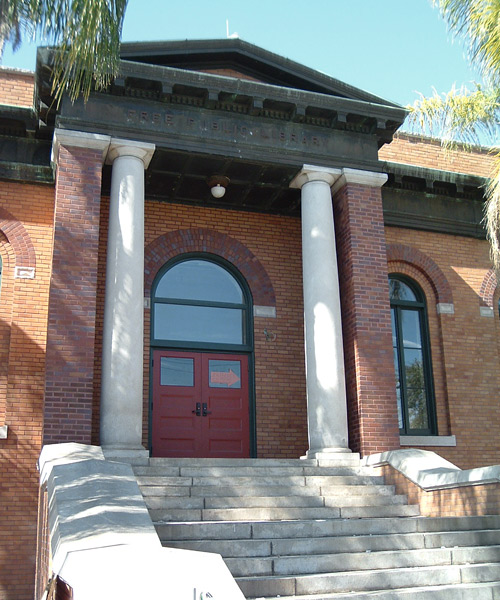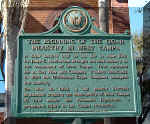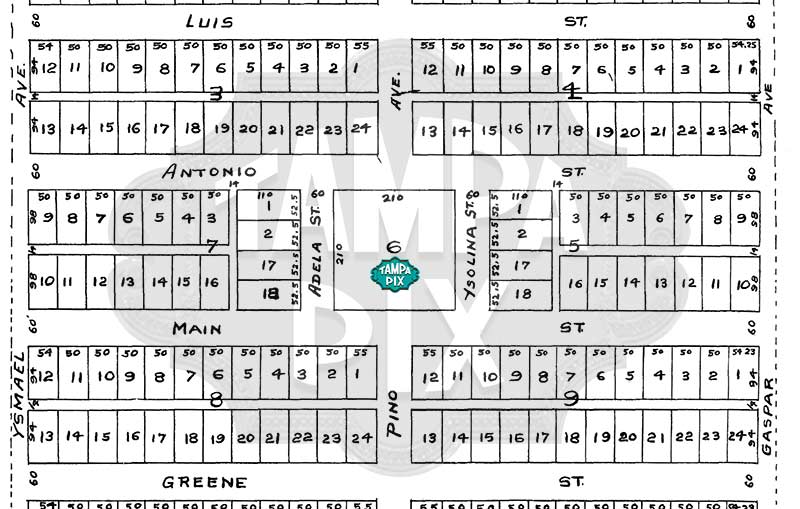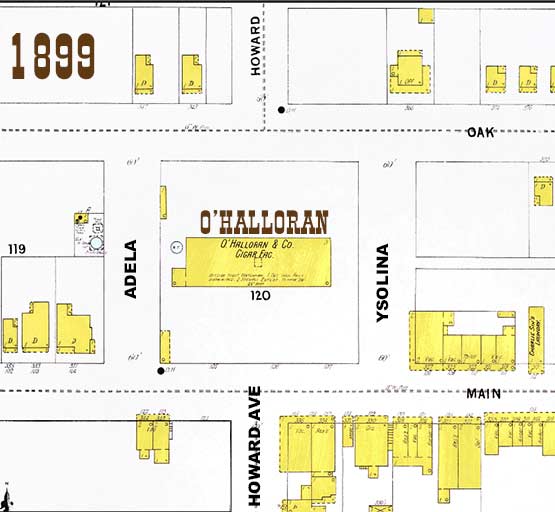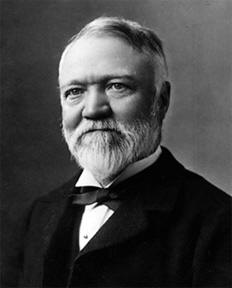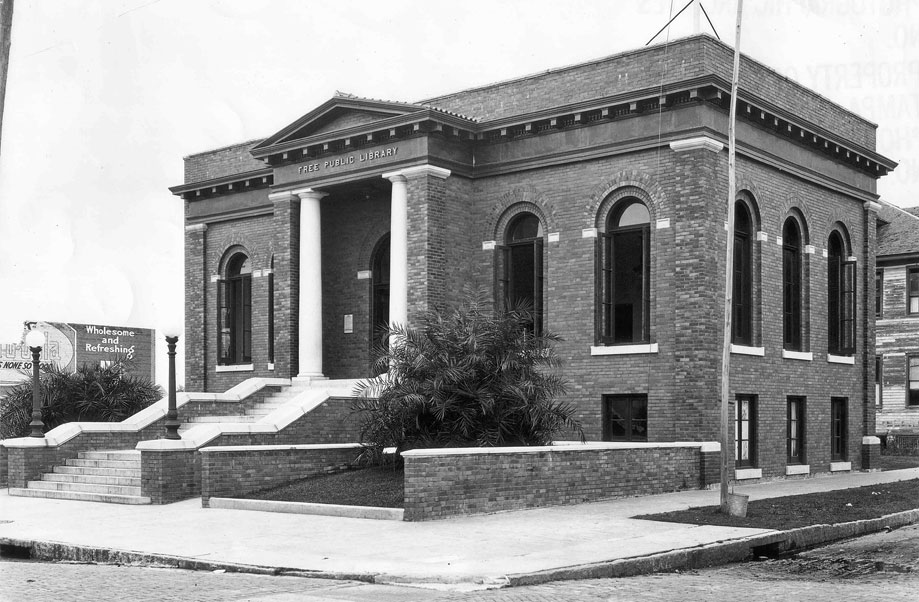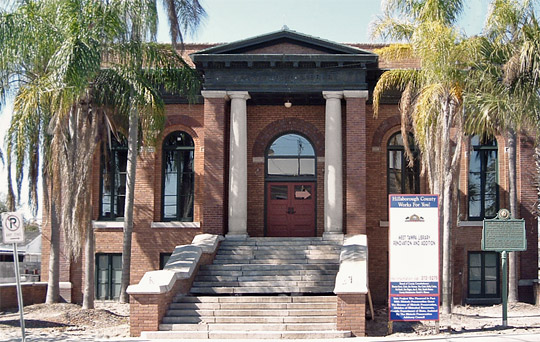|
|
The West Tampa Branch Library on the southwest corner of N. Howard Avenue and Union Street is currently being restored. (2004)
West Tampa was referred to as "Pino City" in 1892 because the del Pino brothers Antonio and Gaspar built their factory in west Tampa in June of 1892, having moved here from Key West. As Hugh Macfarlane developed the immediate area around the factory, the area was referred to as Pino City by the locals. It was never a city nor an official name., west Tampa as a city did not exist before 1895, but the whole area west of the river had always been referred to as "west Tampa." Initially, Macfarlane developed the area with a central square property that interrupted Howard Ave. (at the time named Pino Ave.) between Main St. and Oak St. (now named Union St.) On the east side of the square was Ysolina Avenue, and on the west side was Adela Ave. These were two, short, one-block streets. Today, Ysolina still exists. Because of lack of housing, transportation and convenient access, the del Pino factory closed in 1893. In 1894, O'Halloran Cigar Company moved from Key West into the vacant 3-story del Pino brothers building. The O'Halloran cigar factory burned down in 1901 as a result of arson during a workers strike. The rubble was cleared and Howard Ave. was cut through the middle of the property to make the main thoroughfare uninterrupted. In 1902 the Fernandez Brothers opened a factory where Adela Ave once was located. Adela was filled in to become usable property in 1901. This, another wooden factory, closed in 1909 and it burned down in May of that year. In 1913, this became the site of the West Tampa free Carnegie Library, seen here. |
||||
|
Hugh Macfarlane's West Tampa addition plat filed in March 1892 shows the original layout and street names planned for the first phase of his development. Antonio and Gaspar were the del Pino brothers. Ysmael, Ysolina and Adela were probably their wives and/or children. The del Pino brothers factory was the first in west Tampa in June 1892. |
|||||
|
|
|||||
|
Story from County's Oldest Library a West Tampa Treasure by Kathy Steele
The West Tampa Free Public Library was a gift from one immigrant - Scotsman and philanthropist Andrew Carnegie - to many more immigrants who sought the American Dream. In 1913 a tract of land off Howard Avenue was bought for $6,000 from Macfarlane Investment Co. and construction began on what today is the oldest of Hillsborough's 25 operating libraries. On New Year's Day 1914 a grand celebration marked the opening of the first library in Hillsborough County. It was one of 10 Carnegie libraries built in Florida from the early 1900s to about 1917. According to an account in the Tampa Morning Tribune, the building was filled with potted plants and flowers and the flags of the United States, Cuba, Spain and Italy. Three languages were spoken - English, Spanish and Italian - in acknowledgement of Tampa's immigrant population, many of whom worked in the cigar factories of Ybor City and West Tampa.
The West Tampa library, with its Spanish-language reading section, was a success. Often the readers, or lectors, who entertained and enlightened the cigar factory's workers found their books at the West Tampa library. Carnegie began donating money to build libraries in the early 1900s. He had amassed a fortune as a steel magnate and builder of bridges, locomotives and railways. His family migrated from Scotland when Andrew was 13 years old. Carnegie's first job was in a Pennsylvania cotton factory. In an 1889 essay, "The Gospel of Wealth", Carnegie preached that the wealthy were morally obligated to use their money to benefit the "common man." In 1913 he offered to donate $17,500 for construction of a library building in the city of West Tampa. Residents voted in a special election to accept the donation and a yearly tax to pay for the library's operating costs. The vote was 352 to 1. The identity of the lone dissenter isn't available. But critics of Carnegie said the industrialist was more interested in vanity monuments than in doing good works.
Carnegie had a reputation for being exacting in how he wanted his libraries designed. Patrons, he thought, should walk up grand stairways to enter the library as if climbing steps toward higher learning. Many of the more than 1,600 libraries built with Carnegie's donations were sturdy, imposing structures. The West Tampa library is in a Neo-classical revival style and is part of the West Tampa national historical district. Carnegie even insisted on something rare in Florida: a basement. A Tampa city clerk, James Biggars, tried to explain basements were not successful in Florida. Carnegie got his way. Every time it rained the basement flooded. There were other issues. The building was like a refrigerator on cold days. Electricity was turned on and off at a wall panel that often shocked the user.
In 2004 the library
completed a major renovation and expansion. The library's main floor
became a second floor
meeting room. An extension of 5,000 square feet was added to the back of
the building and what was once the basement level became the library's
main reading room. A lobby is decorated with paintings by Ferdie Pacheco
and stained-glass windows were installed in the reading room. A cork tile
floor was pulled up from the old reading room, revealing a wooden floor
peppered with tiny nail holes which remain visible.
|
|||||
|
Historical Markers of West Tampa
|
|
|
|
Many of the streets that run East/West in West Tampa are still paved with brick.
Chestnut St. |
